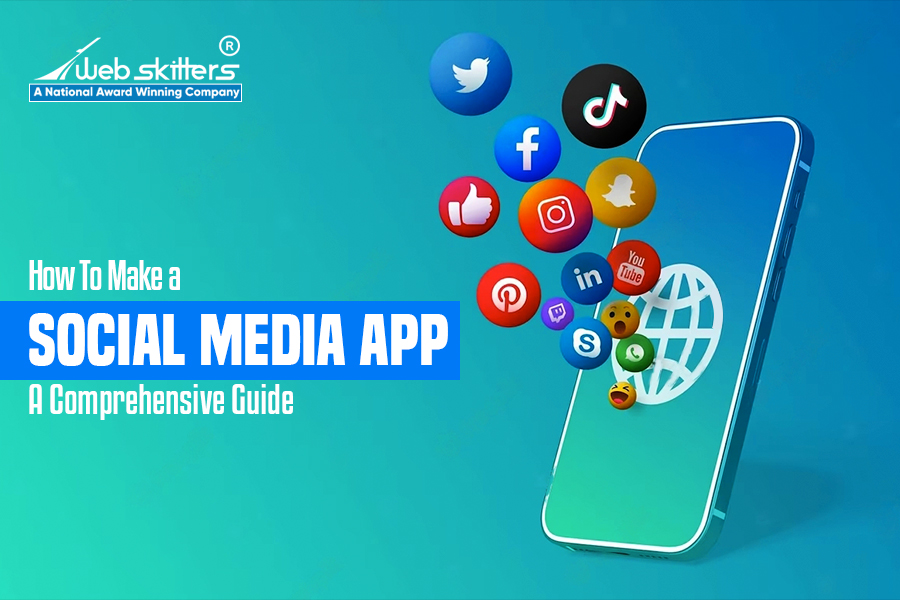
How to Create a Social Media Marketing Plan in 10 Steps
In today’s world, where every aspect of the market is digitally driven, it is crucial for businesses and individuals to have a strong social media marketing plan. Social media platforms like Instagram, Facebook, Twitter, and LinkedIn have modified the way companies engage with their audience.
Social media platforms offer many opportunities to reach, interact, and develop lasting customer relationships. Effective social media planning is critical to brand visibility, customer engagement, and competitive advantage.
A well-crafted Social Media Marketing Plan can bring traffic to the company’s website, generate leads, and boost sales and revenues. In a competitive business environment, the power of social media demonstrates how essential it is to stay relevant and achieve sustained growth.
Do you want to establish your business on social media successfully? The first step is to create a social media management plan.
Developing social media strategies can be overwhelming, especially when launching your brand or building your online presence. There are too many channels, features, tools, and products to fit into the marketing strategy.
Hence, you will require expertise in successfully creating a social media strategy to boost the growth of your businesses.
Implementing a social media strategy is a summary of your plan of action to do and achieve on social media. This strategy helps to guide your action and lets you know if you are succeeding or not.
This blog will walk you through the best ways to create a successful social media marketing plan for your business. We will explore how to make a strategy to boost your brand awareness and allow you to increase your reach to the audience.
Overview of Social Media Marketing Plan
Social media marketing is about using social media channels to promote and sell services or products. Platforms like Instagram, TikTok, YouTube, Facebook, and more offer direct communication with customers.
Various activities on social media might include sharing content, engaging with potential customers, and promoting a new product.
A social media marketing plan crafts how the company achieves its goals on social media. You can now take a more organized and focused approach while building and marketing your brand on social media.
Understanding Social Media Marketing Strategy
A Social media management plan combines different businesses’ marketing goals and plans of action. A simple strategy will help you define your particular target audience, decide what to post on multiple channels, and use tricks to establish business goals.
Crafting a social media strategy will enable you to effectively use your time, identify the channels, and target customers, aiming to make an impact. A good strategy outlines key performance indicators (KPIs) to measure performance and share responses to consumers.
Social media marketing plan offers various marketing functions, including:
- Driving traffic and sales
- Tapping into influencer networks
- Building brand awareness
- Amassing an engaged audience
- Connecting with customers and prospects
- Providing customer support
These are the essential elements included in a marketing plan to streamline the decision-making process, ensure alignment with the business goals, and deliver desired results. A strategic social media marketing plan helps to highlight your organization’s priorities and goals.
There are exclusive benefits of having a well-defined social media marketing strategy for your business, like –
- Set clear goals
One important part of a social media marketing plan is to identify and set clear goals. As you research this strategy, you can opt for smart goals. The goals you set impact your decisions regarding social media marketing.
- Save time
A robust social media marketing strategy helps to save a lot of time. It allows you to plan an outline beforehand and decide what you will post on social media, which eliminates a lot of hassle. This even helps when making the next post on a particular platform.
- Maintain a consistent voice.
It is crucial to stay consistent on social media. All the social media content you post should portray your brand’s voice and values. Building a social media presence can help define your brand’s personality, mission, and values, making staying relevant across all channels easier.
- Measure results
A good strategy helps organizations measure business results and grows their brand on social media. By considering the results, you can identify what is working and what is not, and this can even help you make changes to the strategy according to the requirements.
- Coordinate a multi-channel campaign.
The Social media management plan helps facilitate coordination with multi-channel marketing campaigns, whether you are sharing posts across various social media platforms or utilizing other channels.
A clear marketing strategy allows you to identify opportunities for multi-channel campaigning and cross-channel promotion. This allows you to reach a wider audience and reinforces your brand identity across various marketing channels.
10 Steps to Create A Successful Social Media Marketing Plan
If you want to grow your brand through social media, it is crucial to develop a social media marketing plan. Once efficiently optimized, social media is the ideal way to grow traffic, generate leads, and increase sales for businesses. Here are 10 steps to create a social media marketing plan that will bring about definite results.
Step 1: Define Your Goals
All precise social media strategies have clearly defined goals. Even before working on the strategy, it is important to decide what you want to achieve. Your focus might be to improve brand awareness, enhance engagement, or increase follower count.
You can break down these goals into small parts to make them realistic. These goals will impact other factors of the social media marketing strategy, from the budget to the social media platforms used.
Examples of social media marketing goals
- Increase brand awareness to a better scale: Brand awareness is about making your brand known among common people. Consider your business values or brand personality. Accordingly, to increase your brand awareness on social media, post more authentic content to enhance your brand story and voice.
- Generate leads and sales to a different level: Almost every marketing activity aims to generate revenue. In the same way, social media is considered a revenue-generating channel. With the advent of native shopping features, it is easy to sell through social media.
- Grow social audience to huge followers: Social media is one of the best ways to build community engagement. It is where most people live. Thus, your brand should be able to find new ways to reach out to its audiences, who might be interested in your content.
Step 2: Know Your Audience
As a business owner or marketer, it is vital to understand what your target audience prefers. It is essential to build a target persona for your brand. You should consider factors like age, gender, interests, and lifestyle.
Depending on these factors, you can decide which social media platform is best for your brand to flourish and what content will work. You need to align your social media content strategy to match your audience’s preferences.
To develop a precise social media marketing plan, you should be able to answer the following –
- Which particular social media is accessed by your target audience?
- What kind of content do they prefer?
- What are they avoiding?
- What are the best ways to keep them engaged with brands?
Research your customers
You can understand your target audience by looking for demographic and psychographic data. This will help you form an image of who tends to buy more services from you. Exercising this will help you develop a voice and tone that resonates with your brand.
Here are some methods to know your target audience –
- Run a survey – Collect essential data about your audience and know their age, location, interests, and occupation.
- Conduct interviews – You can communicate with some customers and collect qualitative data regarding their goals, challenges, values, etc.
- Research the competition — See who the biggest competitors are. Look at what characteristics they share and which content they follow and engage with. They can even source other information about their social media profiles.
- Dig into your analytics. Most social media platforms have insights that show information like the age and location of followers.
Create customer personas
Once the basic research is done, you can create customer personas to match each audience segment. This includes –
- Location — Where do the ideal customers live? Knowing their countries helps to understand the focus region; if it is their cities, you can directly cater to them.
- Age and Gender – Know the age range of the customers and the gender they identify with.
- Interests – Understanding the customers’ interests, hobbies, and passions helps in effective targeting options.
- Career/industry — Know in which industry they work and what their job titles are. The relevance of knowing their career depends on the brand.
- Motivation to buy — Know what factors attract customers to buy your product. Understanding their motivation to buy will help enhance your brand’s reach.
Step 3: Choose the Right Platforms
Analyzing social media metrics emphasizes the best-performing platforms based on hour goals to help you decide where to put your focus. It is better to excel in two or three channels to enhance your brand reach consistently.
Every other social media platform offers different functions as it promotes specific types of content. The platforms you choose depend on the audience, products, and the most popular one in the industry.
The Top Social Media Platforms And Their Importance –
- TikTok – It is a video app with a hyper-personalized algorithm. It helps your brand to develop deeper customer connections through unedited videos.
- Facebook is a community-based platform with multiple features for stores, including check-ins and reviews.
- Instagram is a visual platform with various social commerce features suitable for brands that aim to connect with customers and drive sales.
- LinkedIn – LinkedIn is a network-focused platform for connecting with social media influencers and other professionals.
- YouTube – The ideal video platform for growing a community, sharing long content, and engaging traffic to your website.
Step 4: Create Engaging Content
Social media content strategy involves having a good idea of your brand personality, goals, and audiences’ preferences. Even with all the groundwork in place, content creation is not easy. Several content creators struggle to find new variations of content to post.
In some scenarios, you can reuse your old content and add a new format. Another way to create more engaging content for social media is to create content themes. This works well with Instagram and other visual platforms.
You can break down a photo into smaller fragments and upload each fragment separately so that the whole picture is displayed in the feed. You can even upload various photos with a similar theme.
A Few Unique Ideas To Develop Engaging Content –
- Live Videos
- Conduct Polls
- Create Memes
- “Behind-the-Scenes” Videos and Photos
- User-Generated Content
- Infographics
- GIFs
Step 5: Develop a Content Calendar
Consistently posting is the solution when implementing a social media strategy. The ranking algorithm supports the frequency of posting on social media and enables one to gain more visibility by posting more often.
This practice also tells the customers that you are active and can be approached on social media. You can even use multiple tools to schedule your posts and develop a social media calendar to maintain consistency.
Before scheduling the posts, you can check the best time to post for each social media network and track the optimal number of hashtags for each network.
Plan how much time you can dedicate to a social media platform, even if you post once every few days. Eventually, you can grow it to one post a day, analyzing social media metrics to reach larger audiences and get better results.
Each platform has an ideal posting time, depending on when its followers are highly engaged. You can sort the best posting times through trial and error, and the popular posting times vary depending on multiple variables.
Step 6: Implement Social Media Tools
Creating content for various social media channels is hard work, especially if you create different types of content for each account. This is where social media scheduling tools come into play.
These tools help you schedule content beforehand, create attractive graphics, and monitor comments and engagement. Thus, they save a lot of manual work on social media posting. Effective social media management software makes managing and organizing various social media channels easier.
Some Of The Essential Social Media Tools To Consider –
Scheduling Tools
Using an app to schedule your content calendar will help you upload your post within the given time.
- Buffer — Buffer helps you distribute your content to multiple channels at once. This app even tells you when the best time to post is according to the audience metrics.
- Hootsuite — With Hootsuite, you can design, schedule, and publish content from one central dashboard across various networks.
- Later is a social media tool that enables you to schedule your content in bulk across multiple social platforms. Its analytics can help you decide the best time to post.
Content Creation Tools
Use these tools to create on-brand graphics and videos to make your feed look fresh and memorable. The content creation tools are –
- Canva – It presents you with a library of design templates, and you can drag and drop your fonts, graphics, and logo.
- Unsplash – You can access thousands of royalty-free images. This tool lets you edit or use them in your social content.
- Venngage – Create attractive infographics utilizing this tool with pre-made templates.
Step 7: Engage with Your Audience
You must develop strategies to actively engage with your audience, respond to multiple comments and messages, and develop a sense of community.
No one should feel like they are sharing their views in the void, so you must put effort into starting discussions and encouraging interactions regarding the content.
Tips To Develop Social Media Engagement Tactics –
- Reshare content – You can post customer photos and reviews in your feeds to increase engagement.
- Ask questions – You can create an invite and discuss by asking a question.
- Run a poll – Nowadays, almost all social media platforms have a poll feature. You can use them to increase engagement and learn more about your customers simultaneously.
- Join new trends—You must participate in the latest trends or trending hashtags on other channels. This will help make your brand more relevant to the audience.
In this digital age, building meaningful relationships with your audience is essential to transforming them into transactional interactions. You need to engage with your audience, respond to comments, participate in discussions, and incorporate UGC content into your plans.
You must encourage your audience to share their experiences with different products. This creates a sense of community and trust, which strengthens your connection with customers and attracts new ones.
Step 8: Measure and Analyze Results
Using social media analytics tools helps to track the performance of your content and campaigns. The metrics depend on the goals. For example, if you want to boost your website traffic, you can closely track the click-through rates.
Key Metrics to Track and Optimize Social Media Strategy
- Reach – Check how many people are seeing your social media posts in their feeds.
- Engagement – Track how many people like, comment, and share your posts.
- Click-through rate– Check how many people are clicking through your social content to your website or other product pages.
- Conversions – Consider how many people purchase something after seeing a social media post.
Analyzing social media metrics allows making minor changes to your strategies. You can be proactive in the short term and use the learning in future campaigns. Once you understand the average traffic and post-performance, you can set goals for the key metrics and maintain a scorecard to measure your progress.
Step 9: Adjust and Optimize
Building a following, stabilizing your brand, and getting the results of your efforts take time. To gain success, you must experiment with different combinations of channels, content, and messaging. By doing this, you can find what works best for your audience.
You can review your strategies daily to ensure that you’re progressing toward your social media goals. With this, you can compare your actual performance against the benchmarks and KPIs that you have established. You can even identify if there are any gaps or areas that would require improvement.
You must stay informed about the latest trends to develop a social media branding strategy. Track changing social media algorithms, user behavior, various new features, and technologies. Staying updated will help you adapt your approach and maintain relevance and effectiveness in the ever-changing social media scenario.
Step 10: Monitor ROI
Pay advertising is one of the most well-known and data-oriented ways to measure social media ROI. The challenge arises when there is a lack of strategy to ensure a positive return on investment.
Generally, social media marketers build a Google Ads campaign to ensure ranking for important search terms. These campaigns drive clicks, traffic, and even leads, but the ad spend often reduces the impact of the ads, thus resulting in poor ROI.
Most small businesses or social media teams lack the bandwidth to establish and retain a quality presence on every channel. Thus, to bring in the highest ROI, you can focus on specific channels and enhance engagement on those channels.
Different Methods For Calculating ROI And Enhancing The Value Of Social Media Strategy Are –
- Create a budget
- Constant evaluation and performance
- Ensure to amplify the right message
- Determine goals for every channel and evaluate the metrics
- Identify the metrics performing best for your social team
- Monitor your customer acquisition cost
Interesting fact –
Instagram has been the best source of ROI, quality leads, and engagement. As of 2023, 23% of marketers believe that Instagram offers multiple brands the highest potential to grow.
Experience Excellence in Social Media Marketing with Webskitters Technology Solutions
Developing a social media marketing strategy will give you purpose when you reach out to your audience on different platforms. With a social media marketing plan, you can determine the kind of content to post that your audience will like to see and engage with. This will help you grow the audience, increase revenue, and sell more products.
Social media has been constantly evolving, and to up your game, you need to have successful plans and strategies. We at Webskitters Technology Solutions Pvt. Ltd. offer a complete guide to outlining your social media campaign and successfully developing a plan.
We are here to help you identify your target audience and select the most effective channels to reach them. Focus on creating top-notch, highly engaging content to attract your followers, and use data-driven insights to boost your strategy.

 Ecommerce Development
Ecommerce Development 

![31 Latest Web Development Trends in 2023 [Updated] – Webskitters](https://www.webskitters.com/wp-content/uploads/2025/02/6391951191af02680036e736_31-Web-Development-Trends-Featured-Banner.jpg)











